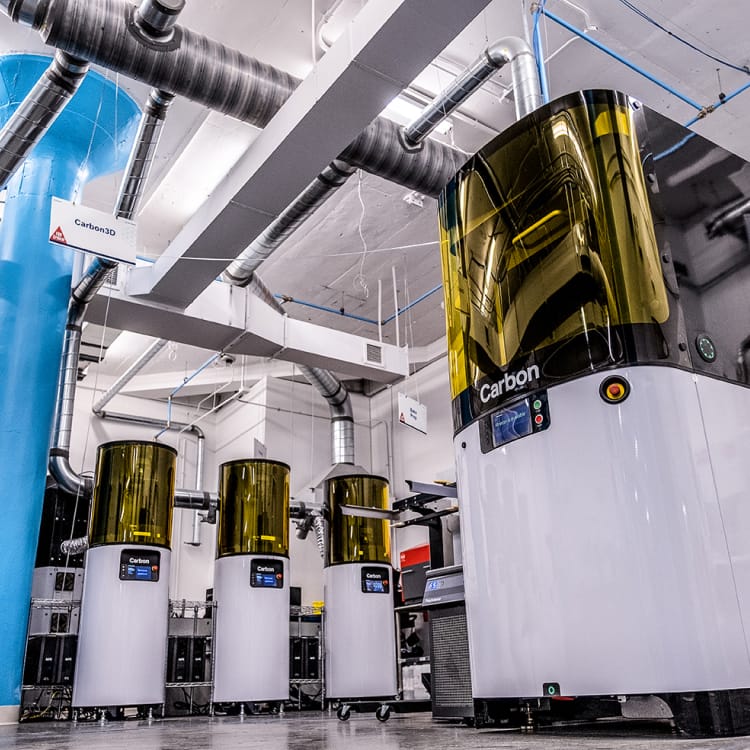Five 2023 Predictions for 3D Printing Businesses
At the recent Photopolymer Additive Manufacturing Alliance executive meeting, I spoke about the additive market cycle and how, despite the bleak trend over the last few months, we’re actually about to enter a great cycle of re-birth. I described our market as a forest – one that moves through cycles of fire, spring, and re-growth. While unfortunate, these fires are necessary to keep our market alive and vibrant with new ideas and technologies.
As I see things, a CEO in Boston started playing with hype and matches to get his SPAC off the ground. This inevitably led to a massive forest fire of investor disillusionment, now fully out of his control. And this fire is in the process of burning a number of companies to the ground. The new saplings which emerged in this last phase of growth established strong customer traction, which grew deep roots that will survive the blaze. Companies that have failed to establish themselves with customer-driven revenues—and can’t seem to get out of their own way—are likely to be reduced to char. In the end, only vulture investors will remain on these sites, picking through the rubble for scraps.
While this can be worrisome to industry insiders watching the downturn, I reminded our Executive Board that the hype and failed business models being carried away by this fire are not the reason they entered this field. And that they aren’t vulture investors, looking to enter and then leave the field with a quick flip. They are long-term investors who believe in the promise of additive manufacturing and are making the necessary investments to grow our field. That this fire is clearing away the underbrush, making room for newer technologies and better go-to-market strategies.
At the end of this burn, we will be entering an exciting phase of re-birth. And while it is important to learn from the past, it won’t do well to dwell upon the charred remains of companies that don’t make it through this fire. Instead, our best efforts are focused on planting the seeds that will become the saplings and trees of tomorrow—when the market goes back into an upswing.
How long it will be before we see this upswing will depend on whether we see a soft or hard market adjustment in the coming months. One is a momentary pause in which we can all catch our breath; the other is a nasty crash that could takes years to recover.
With that in mind, here are my predictions for what will happen in the next several years.
Prediction 1
Established companies with sufficient funds and revenue will survive. They will do this by delaying expansion, cutting costs, and stretching reserves through a bad couple of years.
 Fast Radius had a fleet of Carbon printers. Image courtesy of Fast Radius.
Fast Radius had a fleet of Carbon printers. Image courtesy of Fast Radius.Examples: LuxCreo has slowed expansion plans to stretch runway. Phil DeSimone, Co-CEO of Carbon, has laid off a number of highly experienced (and expensive) 3D printing experts and brought in employees with lower salary points that can sustain the company’s core revenue model. Avi Reichental, CEO of Nexa3D, made hard calls and let go a lot of good people who helped the startup grow to where it is. However, he probably couldn’t afford to keep everyone, with limited expansion plans in some of these verticals. These companies are making the hard, but necessary, expenditure adjustments required to help ensure their funds last the fire.
Prediction 2
Desktop Metal will have bigger layoffs inbound.
 Desktop Metal CEO Ric Fulop. Image courtesy of Desktop Metal.
Desktop Metal CEO Ric Fulop. Image courtesy of Desktop Metal.Reason: Desktop Metal (NYSE: DM) acquired two very strong and profitable companies (EnvisionTEC and ExOne) and saddled them with a series of platforms that are not (yet?) profitable and have high upkeep costs. Their CEO, Ric Fulop, will likely have to make massive layoffs and consolidations to keep his cash position stable. This is sad to watch, as EnvisionTEC and ExOne could have survived this fire on their own and retained a large amount of the talent that made them successful. But, now, they are in a dangerous position, and it’s very likely that some of the great engineers that got ‘acquired’ in these deals will be let-go as they are now ‘redundancies’ and not a part of the core engineering team in Boston. For these engineers I can only advise that they remember success was built upon their shoulders and to recall their worth as they go through these experiences.
If Fulop can’t get down costs while simultaneously pulling up revenue, things will start coming apart as sections of Desktop get re-packaged and sold off. The only option will likely be to make big cuts, similar to those listed above and to those the company has already performed.
Prediction 3
Max Lobovsky, CEO of Formlabs, will continue slow stable growth, launch a more manufacturing-focused platform, and start preparing for an initial public offering/ SPAC when the market recovers to a better position.
 The Formlabs Form Cell Automated manufacturing setup.
The Formlabs Form Cell Automated manufacturing setup.Reason: Lobovsky has always wanted to own the ecosystem, like Fulop. However, instead of relying upon lots of hype, he’s methodically built his company. He’s learned that failure is not fun (see the Form 1 3D printer) and has only put out great market plays since that point (the Form 2 and Form 3). He will re-pivot back to the manufacturing theme to support growth, as he’s seeming to have saturated the at-home market for his printers. The next generation printer will likely look like a Form 3, but will be launched with something similar to the ‘Form Cell’ vision we heard about for the Form 2, but that never fully gained traction and materialized. That launch and play will likely be combined with some move to go public, if the markets have recovered and the valuations make sense. If the values don’t make sense for Formlabs investor SoftBank, the company will stay private and bide its time on good, sustained revenues. Max is too smart to stub his toe this late in the game, and with Nathan Linder backing him up at the Board level, they are likely headed to success.
Prediction 4
Mid-development companies (with products but no customers) will become distressed assets and get gobbled up by 3D Systems (NYSE: DDD), Stratasys (Nasdaq: SSYS), or Nano Dimension (Nasdaq: NNDM) for pennies on the dollar.
 A 3D printed circuit board made with Nano Dimension technology. Image courtesy of Nano Dimension.
A 3D printed circuit board made with Nano Dimension technology. Image courtesy of Nano Dimension.Reason: If you’re not approaching stability, with numerous strong customers and substantive revenue, then you’re hard up for cash right now. You have big overheads and not enough revenue to justify the continued payroll. Strategic layoffs don’t make sense because you need the personnel to establish market traction. As market conditions worsen, customer acquisition will become exponentially harder as the customers, themselves, are in the process of cutting back. If you don’t have deep pockets for the next two to three years… you’re likely screwed.
Add to this that the three big public firms listed are beginning to operate more like 3D printing mutual funds than tech companies (i.e., M&A versus turning out products built in-house). They have made substantial adjustments, downsizing/restructuring internal development in recent years, and they have raised piles of cash. They can either sit on that cash while riding out the forest fire or make strategic investments/acquisitions into/of distressed assets. They might buy out early-stage companies with strong revenue potential, as well, as they need to get their stock prices back up to keep the shareholders happy (see grumbles at Nano Dimension starting). The investors in the mutual funds are looking at their returns. They aren’t easily dazzled by new and exciting technologies brought to market or a few marketing tag lines. They want to see where the revenue growth will come from and really don’t care about 3D printing in the abstract.
Prediction 5
Young startups with promise will still raise funds and emerge stronger on the market rebound.
 A rendering of Vitro3D’s process used to 3D print a part for the dental market. Image courtesy of Vitro3D.
A rendering of Vitro3D’s process used to 3D print a part for the dental market. Image courtesy of Vitro3D.Thoughts: Trailing behind the fire and fueled by rays of light penetrating the newly formed gaps in the canopy, there is always re-growth. A number of new technologies and go-to-market strategies (that hopefully won’t repeat the failures of the last cycle) will emerge and secure a few million here and there. See Vitro3D, Axtra3D, etc. There is money and people are planting seeds – just not at the valuations we’ve seen in the past two years. You won’t see these seeds blossom for two to four years, but we can all hope that they will have learned from the earlier failures in the market this last cycle. Some of the top tech and business development talents, recently laid off, will embed with these companies, either as employees or consultants, and will hopefully help them avoid the pitfalls of the last market cycle.
About the Author
Dr. David Walker is the Executive Chairperson of the Photopolymer Additive Manufacturing Alliance (PAMA), along with being the former President/CTO and the technical Co-Founder of Azul 3D.
David graduated with his PhD from Northwestern University in 2014, during which he studied interfacial surface-phenomena and nano-scale materials. During his doctoral studies he received a Feynman award from the Foresight Institute, an international thinktank, for his contributions to the field of nanotechnology. Following his graduation, David was an Adjunct Professor in Chemical and Biological Engineering at Northwestern University teaching graduate courses in thermodynamics. His ongoing research and technical innovations in robotic driven chemistry for pharmaceutical applications would eventually bring him to the field of additive manufacturing, where he would co-found Azul 3D in 2017. In 2019, David published a seminal work, in the journal Science, which set a new throughput record for the field of vat photopolymerization printing. David would go on to lead Azul 3D, growing the company from zero to 30+ FTEs until his exit in 2022.
Outside of serving as executive chair for PAMA, David serves on the board of RadTech (an industry organization for UV/EB thermoset materials), is an active participant within ASTM F42, serves on the advisory board of multiple 3D printing companies, and writes about technical and business challenges relating to polymer-based additive manufacturing.
 D
D
Subscribe to Our Email Newsletter
Stay up-to-date on all the latest news from the 3D printing industry and receive information and offers from third party vendors.
Print Services
You May Also Like
3D Printing Financials: Prodways Ends 2024 with a Profit
After a tough couple of years, Prodways (EPA: PWG) is starting to bounce back. The French 3D printing company finally made a profit in 2024, improved its operating performance, and...
Blue Origin & Auburn University Use EOS M290 to Study Copper 3D Printing
Blue Origin, the commercial space company built off of investments from Amazon founder Jeff Bezos, has donated two EOS M290 powder bed fusion (PBF) printers to Auburn University’s National Center...
Rocket Lab to Acquire Restructured Laser Communications Provider Mynaric AG
Rocket Lab USA, the Long Beach-based, end-to-end space services company that specializes in producing rockets with additive manufacturing (AM), has announced plans to acquire Mynaric AG, a German provider laser...
3D Printing Financials: Stratasys Ends 2024 with Cost Cuts and Growth Plans
Stratasys (Nasdaq: SSYS) has wrapped up 2024 with stronger margins but a full-year net loss. The polymer 3D printing leader navigated a year of economic headwinds, restructuring efforts, and shifting...



























